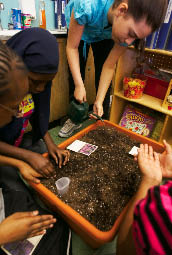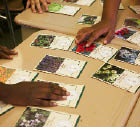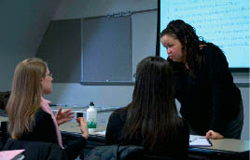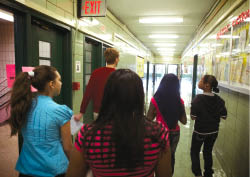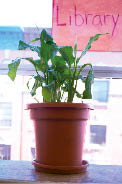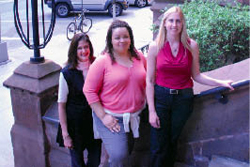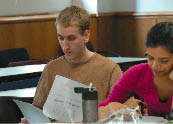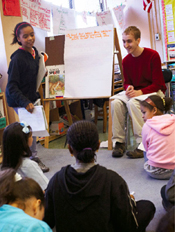Teacher, Observed and Observing
For TC's Elementary Inclusive Education program, "assessment" is an ethos of
knowing one's students and oneself
In a bright morning in March, Colin Schumacher monitors Angelina Gonzalez’s fifth grade class at P.S. 179 in the South Bronx as it practices for an upcoming English Language Assessment test. The children are quiet as they work through a test prep workbook relating to Japanese honey bees.
Schumacher, a student teacher in TC’s Elementary Inclusive Education Program, which prepares teachers for grades one through six, calls time and ushers the children to a space on the rug. Near the window, an oversized pad proclaims, “Good test takers draw conclusions as they read by connecting details to what they already know.”
Schumacher, slight and intensely thoughtful, has been spending a lot of time on this kind of work—highlighting test-taking strategies, emphasizing differences between statements of fact and statements of opinion, and in general employing the Kaplan-oriented test prep that 179 encourages.
“A lot of the stories are interesting,” he says, gamely. “I like the beekeeping one.”
Gonzalez, the head teacher, is glad for his help. “Having two people in the room is really beneficial, because I have a large class with different levels of kids. A lot of them are ELLs [English language learners], and some are struggling and we have to do a lot of basic stuff with them. So we can’t really go out of the box a lot of the time. Though when we do, the kids love it.”
“Out of the box” is where Schumacher really makes his mark. Not long ago, for example, he started a garden club in the class, securing a grant from TC’s Office of Teacher Education and School-Based Support to buy planters and bringing in a Seed Savers catalogue that the children took turns bringing home. (Their assignment: to put yellow stickies next to flowers they liked that would mature by late June.)
Growing gardens with students is a favorite interest of Schumacher’s, but he only suggested it to the students after they introduced him to Henry, the class plant (a lily), which they have been caring for since kindergarten.
“Every weekend they fight over who gets to take Henry home,” he says. Many of the kids had also written in a New Year’s homework assignment about having family members with diabetes and making resolutions to eat more healthily. “So, they like growing things, they have this interest in health. I thought maybe I should ask them if gardening is something they would like to do. Every hand shot up.”
Put to the Test
Over the past 20 years, “assessment” has become the watchword of American education. In a broad sense, it is a proxy for “accountability”—the push to raise performance through state-level standards for what children should know and by when they should know it. That’s a good thing, most people feel, not least because of its equity implications: if the state is going to hold all kids equally to certain performance levels, it must, in theory, also support them equally in reaching those levels.
But in a narrower sense, assessment has come to mean testing—and testing, and testing, and testing. This past semester some Elementary Inclusive student teachers in grades three through five classrooms encountered a two-month stretch in which 75 percent of class time was spent on test prep, bumping social studies inquiry projects, science experiments and more.
Perhaps even more at issue than the quantity of testing is the quality.
“What has assessment really done to poor and marginalized communities and children?” TC Associate Professor Molly Quinn recently challenged students in Elementary Inclusive’s appropriately named Core class—the program’s Thursday evening discussion forum where theory is integrated with practice. “What has it done in terms of curriculum? Has it enriched curriculum? What has it done to the quality of life for teachers and for students? And what, ultimately, are we measuring—genuine growth and understanding, or test-taking skills?”
To underscore those uncertainties, Quinn, who teaches the class along with Clinical Faculty Member Chandra Williams and Instructor Ellie Cook, read her Core students a children’s story about a sheep named Woolbur who drives his parents crazy by creatively misunderstanding the appropriate way to do sheep activities. Does Woolbur have difficulties with learning or just original ways of looking at things? Quinn also shared examples of how children have “misunderstood” questions on standardized tests, like the boy who explained to a researcher that he had paired “old” and “thin” from a word list that also included “down” and “up” because he reasoned that when people get old they tend to get thin. The same boy also concluded that “dog” and “boy” were the best pair out of a list that also included “bark” and “crumble” because a dog is a boy’s best friend.
“You can see what’s lost on paper pencil tests,” Quinn says. “You have the directions, the child responds and there’s no way to get at what he’s thinking when he circles those words.”
To Quinn, however, “assessment” has a deeper and more powerful meaning. “The word literally means ‘to sit beside,’” she says. “If you think what happens when you can sit side by side with your student and see what’s happening, you get a very different sense of not only assessing, but teaching, generally. ‘Sitting beside’ is very intimate—not at all what happens when we work from a testing database.”
It’s that view of teaching that animates the Elementary Inclusive program. Assessment, as Quinn defines it, is the program’s modus operandi, an ethos of constantly observing self, student, classroom, school and community to learn the full context of children’s knowledge, understanding and behavior.
At the heart of that approach is a constant give-and-take between classes and real-world interaction.
“Most programs in teacher education across the country and throughout the world say to students, ‘Take this course, take this course, take this course, then student-teach,’” explains the program’s director, Celia Oyler, Associate Professor of Education. “The student teacher then is in the position of putting together, across the courses and across their field experiences, what it means to be a teacher. We don’t believe that’s the best way to have a curriculum.”
Each semester, the program’s 80-odd students, divided into three cohorts, teach three and a half days a week and maintain a full schedule of classes that, beyond the weekly Core gathering, includes a year-long literacy course. Each semester, in 50-hour practica, each student teacher also investigates his or her school and its surrounding community, visiting classes in other grades and attending community events.
“In our integrated program, when you’re talking about being a teacher, you are applying and talking about management, planning, curriculum, child development and diverse learners at the same time,” says A. Lin Goodwin, Professor of Education and TC’s Associate Dean of Teacher Education. “Because that’s what teaching is. And without constantly relating theory and practice, it’s like trying to learn tennis without actually hitting a ball.”
The Elementary Inclusive program also is unique in how it matches student teachers to cooperating teachers—head teacher/mentors in the community, like Angelina Gonzalez. “At a lot of universities, including our biggest competitors in New York City, student teachers simply show up at the schoolhouse door and the principal distributes them around the school,” Oyler says. “For us, it’s relationship-building over time. And it takes a ton of time. Six of our placements in January fell through because of somebody having surgery or something happening. So we had to go out and get six more.”
Each student gets not one but two such placements—“Two contrasting environments where we think they will be successful,” Oyler says. (Every student teacher at TC completes a minimum of twice the number of hours required by New York State for student teaching, and some programs require as much as three times the required number of hours.) Everything that happens in the classroom is fodder for study back in the Core.
“One of our major goals is to critique the common practices of schooling,” Oyler says. “We want students to understand the big implications of small practices. And if you inventory a teacher’s practices in a day, there’s a thousand of them. You’re always making decisions. Teachers are decision makers.”
Clearly the approach is working. Elementary Inclusive ranks the highest in US News and World Report of any TC program. “Principals across the region tell us our students are the best candidates they interview,” Oyler says. “And the New York City Department of Education hires a higher percentage of our students than from any other teacher education program in the city, even though we don’t produce the most teachers.”
Going Deep
In a workshop on classroom-based assessment that is part of the Core class, Chandra Williams is talking to student teachers about The Look.
“I know you know that look.” She describes the puzzled expression that crosses students’ faces, often just when a teacher thinks she’s on a roll. “I knew that look when I was a student teacher. It was the worst feeling, especially when you’re being observed. And you’re thinking, ‘Come on, you know this, don’t mess up my perfect lesson.’”
The point: assessment can be as simple—and crucial—as reading faces.
A TC alumna and Elementary Inclusive graduate who teaches fifth grade at P.S. 180, near the College, Williams goes on to share a grab-bag of techniques for keeping tabs on student understanding. These range from specific practices, such as asking for answers from the entire class in a whisper and listening for who is and isn’t responding, or requiring periodic letters from students about how class is going, to building a sense of community in the classroom so children are comfortable admitting they don’t understand something.
“One thing I know that I definitely felt as a teenager or a preteen in school: I felt like I didn’t have a voice and no one was listening to me,” she says. “That’s not a good feeling. Ever. So I make it very clear I’m strict. But I make it clear they have a voice in my classroom and their ideas matter.”
When her students take standardized tests, Williams says, she does everything she can to diffuse the tension. “I’m not naïve enough to think, oh well, test scores don’t matter,” she says. “I don’t want them to matter as much as they do. But I know that they do. So I’ll talk about how I get nervous, too, when I take tests, and strategies that I do as Chandra the person. I go through a whole big process of breathing, of sparkles, of giving each other good luck. If it’s a big test, I go around and shake their hands and do something silly just to lighten up the mood.”
These practices keep it low-key for students—but for Williams, who came to TC after an extremely challenging stint teaching in an under-served public school in Washington, D.C., they are equally or even more important as a way for teachers to keep their students in perspective as human beings.
“You will hear teachers say, ‘He’s a two or she’s a three,’” Williams tells the Core cohort, referring to the state’s grading system for standardized tests. “And you’ve got to think when you hear that—what does that really tell you about a child?”
“You may even hear teachers or administrators say things like, ‘A moveable two or a low two,’” adds Ellie Cook. Critics have charged that, in an effort to show “AYP” (adequate yearly progress, as stipulated by the federal No Child Left Behind law), schools sometimes focus their efforts on improving, even if just by a few points, students near a higher bracket. “I would encourage you as teachers to think pretty carefully about these labels and the way resources end up being allocated according to whether a child is a moveable two or a non-moveable two. Think about equity and equality.”
That focus extends to looking at oneself, as well. One of the students’ earliest assignments in the Elementary Inclusive Core class is an intensive exercise in self-scrutiny.
“People don’t look critically at where they’re located in the world very often,” Molly Quinn says. “We don’t see what our prejudices are. The goal through the first semester is to focus on the student teacher as an individual, beginning with the inner life. Really take a hard look at who you are and what you bring: strengths, aspirations and imaginative callings, as well as misconceptions and limited viewpoints. The idea is for students to look at how their visible and invisible assumptions might impact the way they see schools, the child in front of them, an interaction, what their job is, assessment, knowledge.”
For Cook, a TC alumna and doctoral student in the Department of Curriculum & Teaching, self-scrutiny is particularly important given the dynamics of some of the classrooms in which the student teachers are teaching.
“As the teacher, you really need to examine things critically in terms of race, socioeconomic status and the idea of disability and ability, and how those things may create a culture of power in the classroom,” Cook says. “You need to locate yourself in that culture of power, and that can be emotional for many of our students. They grapple with it, because often they think, ‘Certainly I’m not a racist, so why do I need to talk about this?’”
Quinn believes such processes are crucial in making teachers because teachers are fundamental in making society.
“Education says something about what a society views as sacred,” she says. “In terms of public education and a democratic society, it’s the terrain for the democratic project, for realizing a project that has not yet been fully realized. So one would hope that teachers are the most wide-awake and conscious people on the planet.”
Recharging the Batteries
To serve as a cooperating teacher, supervising graduate assistant or clinical faculty member in the Elementary Inclusive program is no light undertaking. Supervisors like Ellie Cook visit student teachers’ classrooms five times in a semester. Cooperating teachers take a role in mid-term and final evaluations.
“Our cooperating teachers truly embrace their role on our team of educators,” says Student Teaching Coordinator Megan Lawless, who personally interviews each cooperating teacher candidate. “And we talk about at that initial meeting. This is a team effort toward teacher education. And we’re not talking about scripted, prescribed teaching where teachers have no need to think or make decisions. Our focus is on teacher decision-making and what that looks like in classrooms. Our cooperating teachers are committed to that because they want thoughtful colleagues who get that we’re trying to teach children and not just a curriculum.”
Indeed, in a system marked by an ongoing disconnect between the profession’s highest aspirations and its inescapable realities, cooperating teachers regularly request return engagements, in no small part because the program encourages them to grapple with that disconnect rather than accept it.
That’s not lost on students like Colin Schumacher. “The conversations that I have with fellow educators—it’s a never ending sort of exploration, reflection on yourself and what you’re doing in the classroom,” he says. “And what you can do better and how you’re reacting to the lives of the students. It’s like what Celia told us recently. ‘If you remember anything about this program, remember this, Don’t abdicate your right to be a thinking person.’”
A new harvest
After lunch back at P.S. 179, the members of Schumacher’s garden club eagerly return to plant their first seeds, which they chose partly in hope of attracting butterflies.
“We have five bins, and we’re not going to have time for all of them,” Schumacher begins. “So I was wondering which one we should work on today. The one that I thought you might be interested in is the one for bees and butterflies. The first thing we need to do is to water the soil.”
Later, after all of the plants are chosen and preliminary watering has been completed, there is just enough time to get all of the seeds planted before the rest of the class returns.
Published Wednesday, May. 19, 2010
